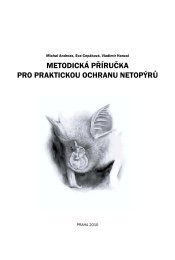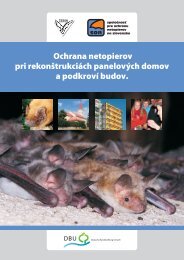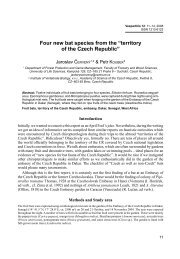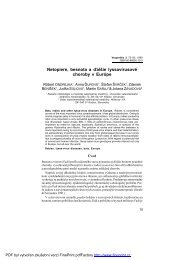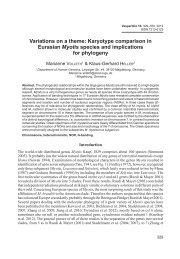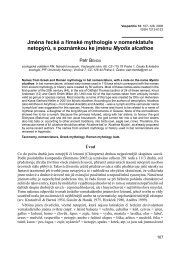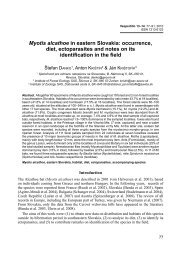Review of sex ratio in several bat species inhabiting the Great Indian ...
Review of sex ratio in several bat species inhabiting the Great Indian ...
Review of sex ratio in several bat species inhabiting the Great Indian ...
You also want an ePaper? Increase the reach of your titles
YUMPU automatically turns print PDFs into web optimized ePapers that Google loves.
Table 1. Status <strong>of</strong> <strong>sex</strong> <strong>ratio</strong> <strong>of</strong> different <strong>species</strong> <strong>of</strong> <strong>bat</strong>s studied <strong>in</strong> <strong>the</strong> Jodhpur region<br />
Tab. 1. Pomer pohlaví u rôznych druhov netopierov skúmaných v regióne Jodhpuru<br />
Legend / legenda: N – total number <strong>of</strong> counted <strong>bat</strong>s for <strong>the</strong> <strong>sex</strong> <strong>ratio</strong> / celkový počet skúmaných netopierov;<br />
M – number <strong>of</strong> males / počet sam cov; F – number <strong>of</strong> females / počet samíc<br />
<strong>species</strong> / druh N M % F %<br />
Pteropus gi gan teus 890 674 75.7 216 24.3<br />
Rh<strong>in</strong>opoma microphyllum 248 94 37.9 154 62.1<br />
Rh<strong>in</strong>opoma hardwickii 73 23 31.5 50 68.5<br />
Taphozous perforatus 25 17 68.0 8 32.0<br />
Taphozous nudiventris 60 23 38.3 37 61.7<br />
Rh<strong>in</strong>olophus lepidus 32 12 37.5 20 62.5<br />
Scotophilus heathii 56 37 66.1 19 33.9<br />
Pipistrellus tenuis 89 48 53.9 41 46.1<br />
The microchiropteran <strong>bat</strong> <strong>species</strong> were caught <strong>in</strong> various roosts; Mandore Tunnel (26° 21’ N, 73° 02’ E),<br />
Deval <strong>of</strong> Maharaja Shri Gaj S<strong>in</strong>gh I (26° 21’ N, 73° 02’ E), Deval <strong>of</strong> Maharaja Shri Ajit S<strong>in</strong>gh (26° 02’ N,<br />
73° 02’ E), Palm Tree Plantation (26° 21’ N, 73° 02’ E) <strong>of</strong> <strong>the</strong> Mandore garden; Dark <strong>in</strong>terwoven cave <strong>of</strong><br />
Daijar Mata Temple (26° 23’ N, 73° 03’ E); An unattended bungalow <strong>of</strong> Krishna Nagar Colony (26° 14’ N,<br />
73° 02’ E); Sagi kee Bhakari <strong>of</strong> Jhalamand (26° 13’ N, 73° 07’ E), and Open Convocation Pandal <strong>of</strong> J. N.<br />
V. University (26° 15’ N, 73° 01’ E).<br />
It was observed that females were dom<strong>in</strong>ated <strong>in</strong> <strong>the</strong> populations over <strong>the</strong> males <strong>in</strong> <strong>the</strong> <strong>Great</strong>er mouse-tailed<br />
<strong>bat</strong>, Rh<strong>in</strong>opoma microphyllum, Lesser mouse-tailed <strong>bat</strong>, R. hardwickii; Naked-rumped tomb <strong>bat</strong>, Taphozous<br />
nudiventris, and Blyth’s horseshoe <strong>bat</strong>, Rh<strong>in</strong>olophus lepidus. Out <strong>of</strong> 248 <strong>in</strong>dividuals <strong>of</strong> R. micro phyl lum and<br />
73 <strong>in</strong>dividuals <strong>of</strong> R. hardwickii caught from different roosts <strong>in</strong> Jodhpur females were dom<strong>in</strong>ated by its 62.1%<br />
and 68.5% share, respectively, whereas <strong>of</strong> <strong>the</strong> 60 <strong>in</strong>dividuals sampled <strong>of</strong> T. nudiventris 61.7% were females.<br />
Likewise, out <strong>of</strong> 32 <strong>in</strong>dividuals <strong>of</strong> R. lepidus sampled, 62.5% were females (Table 1).<br />
However, males were found dom<strong>in</strong>ated <strong>in</strong> <strong>the</strong> populations <strong>of</strong> <strong>the</strong> Egyptian tomb <strong>bat</strong>, Taphozous perforatus<br />
and Asiatic <strong>Great</strong>er yellow house <strong>bat</strong>, Scotophilus heathii. Of <strong>the</strong> 25 <strong>in</strong>dividuals <strong>of</strong> T. perforatus sampled,<br />
68% were males, likewise out <strong>of</strong> 56 <strong>in</strong>dividuals <strong>of</strong> S. heathii, 66.1% were males (Table 1).<br />
Although no any population <strong>of</strong> <strong>Indian</strong> pygmy <strong>bat</strong>, Pipistrellus tenuis, could be located at roosts but <strong>the</strong><br />
samples <strong>of</strong> this <strong>species</strong> collected by deploy<strong>in</strong>g <strong>the</strong> mistnets <strong>in</strong> its forag<strong>in</strong>g area reveals that males and females<br />
shares almost equal percentage. Out <strong>of</strong> 89 <strong>in</strong>dividuals <strong>of</strong> P. tenuis caught at various places <strong>in</strong> Jodhpur males<br />
were dom<strong>in</strong>ated with 53.9% <strong>of</strong> its share (Table 1).<br />
Conclusively, <strong>in</strong> <strong>the</strong> Jodhpur region, it was observed that males were dom<strong>in</strong>ated <strong>in</strong> roosts <strong>of</strong> P. giganteus,<br />
T. perforatus, and S. heathii, while females dom<strong>in</strong>ated <strong>in</strong> roosts <strong>of</strong> R. microphyllum, R. hardwickii, T.<br />
nu di vent ris, and R. lepidus. Male and females shared equal percentage <strong>in</strong> population <strong>of</strong> Pipistrellus tenuis<br />
sam pled by mist-nett<strong>in</strong>g.<br />
Súhrn<br />
Prehľad pohlavného pomeru u niekoľkých druhov netopierov obývajúcich Veľkú Indickú púšť.<br />
S cieľom preskúmať pomer pohlaví rôznych druhov ne topierov v Jodhpure a v okolí vo Veľkej Indickej púšti<br />
sa realizovalo náhodné vzorkovanie netopierov v rôznych úkrytoch. V populáciách Rh<strong>in</strong>opoma microphyllum,<br />
R. hard wic kii, Taphozous nudiventris a Rhi no lo phus lepidus do mi no va li samice, u Pteropus gi gan teus, Taphozous<br />
perforatus a Scotophilus heathii pre vlá da li samce. Vyrovananý pomer samcov a samíc v sledovnom<br />
území sa zistil v populácii Pi pis t rel lus tenuis.<br />
234




